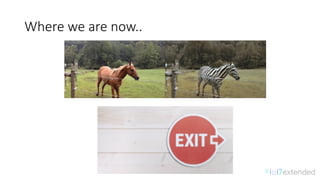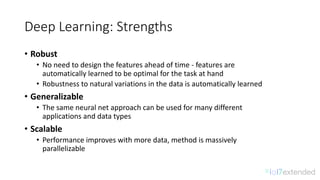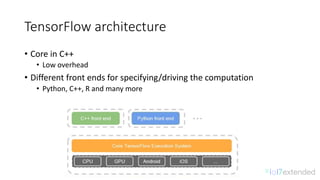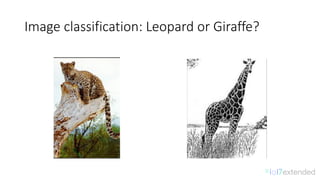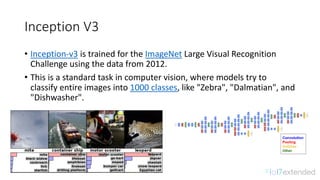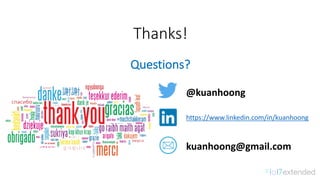Explore and Have Fun with TensorFlow: Transfer Learning
- 2. About me Poo Kuan Hoong, http://www.linkedin.com/in/kuanhoong • Senior Manager Data Science • Senior Lecturer • Chairperson Data Science Institute • Founder R User Group & TensorFlow User Group • Speaker/Trainer • Senior Data Scientist
- 3. TensorFlow & Deep Learning Malaysia Group The TensorFlow & Deep Learning Malaysia group's aims are: • To enable people to create and deploy their own Deep Learning models built using primarily TensorFlow or other Deep Learning libraries. • To build the key skill sets for this group from the combination of both beginner and intermediate models as well as advancing to the next level • A knowledge sharing and presentations platform in relation to the cutting edge deep learning research papers and techniques.
- 11. Deep Learning: Strengths • Robust • No need to design the features ahead of time - features are automatically learned to be optimal for the task at hand • Robustness to natural variations in the data is automatically learned • Generalizable • The same neural net approach can be used for many different applications and data types • Scalable • Performance improves with more data, method is massively parallelizable
- 12. Deep Learning: Weaknesses • Deep Learning requires a large dataset, hence long training period. • In term of cost, Machine Learning methods like SVMs and other tree ensembles are very easily deployed even by relative machine learning novices and can usually get you reasonably good results. • Deep learning methods tend to learn everything. It’s better to encode prior knowledge about structure of images (or audio or text). • The learned features are often difficult to understand. Many vision features are also not really human-understandable (e.g, concatenations/combinations of different features). • Requires a good understanding of how to model multiple modalities with traditional tools.
- 15. What is TensorFlow? • URL: https://www.tensorflow.org/ • Released under the open source license on November 9, 2015 • Current version 1.2 • Open source software library for numerical computation using data flow graphs • Originally developed by Google Brain Team to conduct machine learning and deep neural networks research • General enough to be applicable in a wide variety of other domains as well • TensorFlow provides an extensive suite of functions and classes that allow users to build various models from scratch.
- 17. TensorFlow architecture • Core in C++ • Low overhead • Different front ends for specifying/driving the computation • Python, C++, R and many more
- 18. TensorFlow Models https://github.com/tensorflow/models Models • adversarial_crypto: protecting communications with adversarial neural cryptography. • adversarial_text: semi-supervised sequence learning with adversarial training. • attention_ocr: a model for real-world image text extraction. • autoencoder: various autoencoders. • cognitive_mapping_and_planning: implementation of a spatial memory based mapping and planning architecture for visual navigation. • compression: compressing and decompressing images using a pre-trained Residual GRU network. • differential_privacy: privacy-preserving student models from multiple teachers. • domain_adaptation: domain separation networks. • im2txt: image-to-text neural network for image captioning. • inception: deep convolutional networks for computer vision.
- 19. Transfer Learning : Idea • Instead of training a deep network from scratch for your task: • Take a network trained on a different domain for a different source task • Adapt it for your domain and your target task
- 23. Why use a pre-trained model? • It is faster (it’s pre-trained) • It is cheaper (no need to have GPU farm) • Achieve good accuracy
- 24. ImageNet • ImageNet is an image database organized according to the WordNet hierarchy (currently only the nouns), in which each node of the hierarchy is depicted by hundreds and thousands of images. • Currently there are over five hundred images on average per node.
- 25. Inception V3 • Inception-v3 is trained for the ImageNet Large Visual Recognition Challenge using the data from 2012. • This is a standard task in computer vision, where models try to classify entire images into 1000 classes, like "Zebra", "Dalmatian", and "Dishwasher".
- 27. Transfer Learning • Pre-trained model has learned to pick out features from images that are useful in distinguishing one image (class) from another. • Initial layer filters encode edges and color, while later layer filters encode texture and shape. • Cheaper to “transfer” that learning to new classification scenario than retrain a classifier from scratch.
- 28. Transfer Learning • Remove the Fully Connected (Bottleneck layer) from pre-trained ImageNet Inception v3 model. • Run images from Dataset through this truncated network to produce (semantic) image vectors. • Use these vectors to train another classifier to predict the labels in training set. • Prediction • Image needs to be preprocessed into image vector through truncated pre-trained ImageNet Inception v3 model. • Prediction made with second classifier against image vector
- 29. Further Fine Tuning… • Remove bottleneck (classifier) layer from pre-trained network. • Freeze all weights except the last (few) convolutional layers. • Attach your own classifier to the bottom. • Train the resulting classifier with very low learning rate. • Computationally more expensive than Transfer Learning but still cheaper than training network from scratch. • More robust model.
- 30. Transfer Learning with TensorFlow • Transfer learning does not require GPUs to train • Training across the training set (2,000 images) took less than a minute on my Macbook Pro without GPU support. This is not entirely surprising though, as the final model is just a softmax regression. • With TensorBoard, it is able to provide summaries that make it easier to understand, debug, and optimize the retraining. • It is also able visualize the graph and statistics, such as how the weights or accuracy varied during training. • https://www.tensorflow.org/tutorials/image_retraining
- 32. Summary • Possible to train very large models on small data by using transfer learning and domain adaptation • Off the shelf features work very well in various domains and tasks • Lower layers of network contain very generic features, higher layers more task specific features • Supervised domain adaptation via fine tuning almost always improves performance









